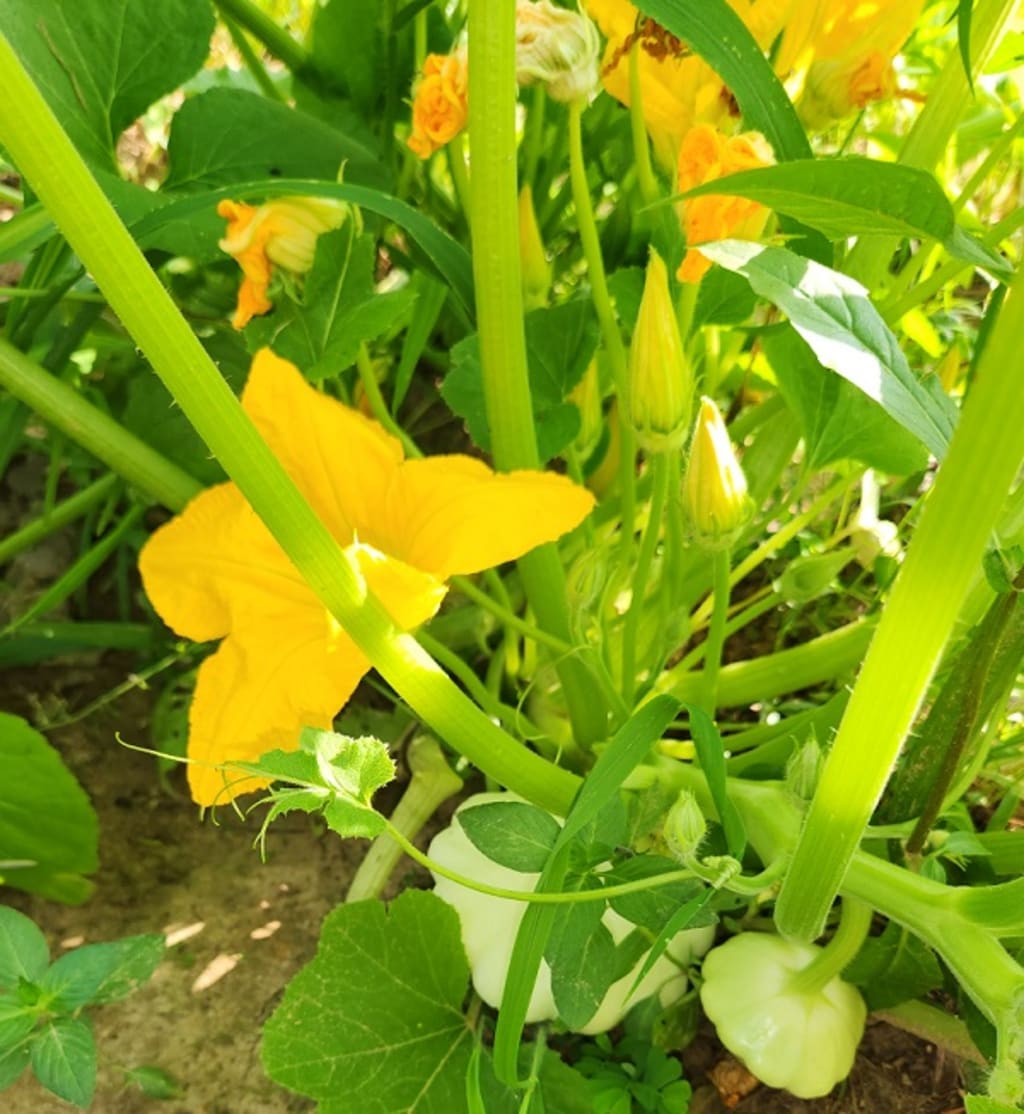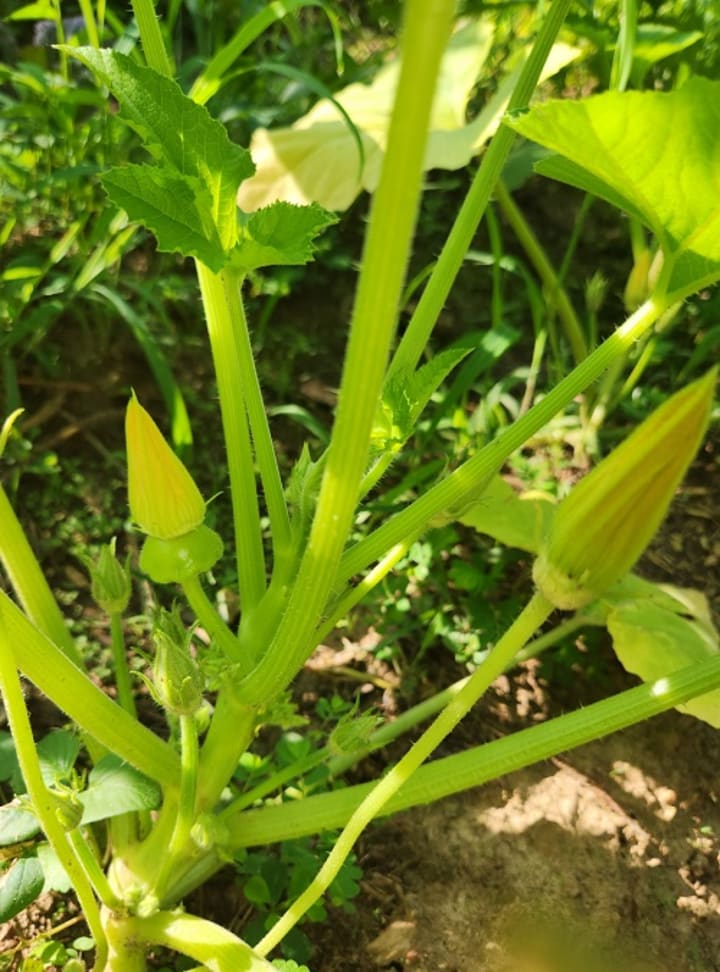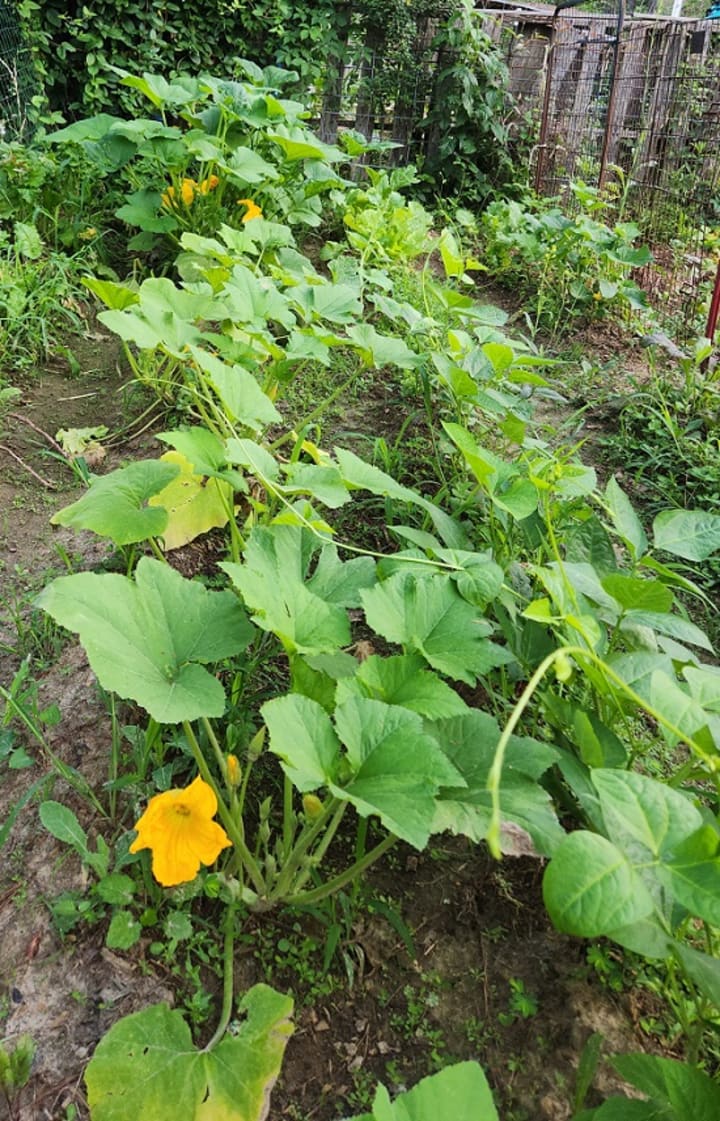Pattypan Squash!
Do you love them? Raise your hand!

Growing Up "BP" (Before Pattypan)
After leaving Fort Bragg, my family lived in New England. I grew up during the sixties and seventies, long before the Internet became a thing and before Walmart was a major grocery retailer. Not only did we eat a lot of local produce, but I had no idea that certain types of food outside our region existed. "Lettuce" meant iceberg lettuce or, if you were fancy, Boston Bibb. Ear corn from the was mostly a solid yellow variety of moderate sweetness, although we got some butter-and-sugar corn from local growers and from my grandfather Cabral's garden. And squash? Yellow crookneck and zucchini were grown locally. Anything else--usually winter squashes, primarily acorn--came out of the store, whether fresh, frozen, or in a can. I liked my veggies, but they were "same old, same old."
Moving to Georgia in adulthood opened up my eyes to a new way of eating. I began to understand okra and various "greens." I could have Vidalia onions for more than a week in the store or at the farmer's market. Corn came in varieties. By the time I reached Mississippi by way of Texas and Louisiana, I had discovered mirlitons/chayote squash and had learned ways of eating veggies that would have given my New England self the vapors! But, pattypans? It took Farmville--and Dan--to teach me about pattypan squash.
Discovering Pattypan (Sort Of)

I didn't play Farmville for long. It was early days for me on Facebook and I had no idea how the whole thing worked. I like the games, but they grew increasingly invasive--half my feed seemed to consist of game requests--so I stopped playing them at all after a couple of years. I forgot about pattypans, still believing that they were just a game construct, and went about my life. Shortly afterward, I started working with Dan during the winter, processing venison. We already knew each other from showing dogs, so we had great visits that first winter, discovering our mutual love of gardening and of learning new things. He listened politely as I complained about the rockiness of the soil at my then-current address and, as winter turned into spring, equally as politely offered me two rows in his garden to plant my tomatoes and other things. What can I say? From such little things, great relationships are born!

One day, right about this time of year, I was walking past one of his little rotation plots when I spotted a tiny white flying saucer at the base of one of his squash plants. As they say: mind. blown. Dan, always willing to share gardening knowledge, spent the afternoon dispelling my myths about the tasty little things, offering to cook one for me as soon as they were mature. Just a few days later, I had my first taste of pattypan squash, lightly brushed with olive oil and spices, roasted with homegrown onion. I thought it was the most amazing thing I had ever tasted. Well, the nice thing about growing your own vegetables is that you can multiply that experience over years, always tasting the most amazing thing ever as you experience new recipes and change them to make them your own. I have yet to be disappointed with any recipe for these little squashes and, today, I get to taste my first pattypan ever out of my own garden.
Growing Pattypan Squash
My little garden still has terrible soil. When I first started working it, I had a bunch of weeds, a scraping of topsoil, and a layer of clay that seemed to extend to extend clear through the Earth's mantle (roughly 3000 km/1864 miles, for those who want to know. I may be exaggerating, but only slightly). Dan and I tilled the space I'm currently working one spring. I hoed and cultivated, pulled out grass and weeds, and hoed and cultivated some more. There was not a worm or an insect to be found in the entire plot. That fall we scattered mustard seeds in--every single one was lost to the elements. The following spring--last year, 2023--we tilled again. I scattered in a load of goat poo and a bit of compost and got a nice little garden started, until the drought killed every plant down to the ground. I worked the ground again in the fall, adding even more organic matter and cultivating the previous plants into the soil. Some very nice mustard plants survived the winter, and a smattering of beets bravely provided me with a side dish.

Why do I mention all this? Because this spring I cultivated the same area--no tilling needed this year! I added enough organic matter last year for my scraping of topsoil to become a couple of inches. Not great, but better. And, amazingly, it was good enough for growing pattypan squash! The seed company will tell you that pattypan seeds need to be planted roughly 18 inches apart in well-drained fertile soil. Considering the average pond developer would be impressed with my clay's ability to turn a rainfall into a flood, I would say that the seed companies tend to report the ideal conditions under which these seeds perform. Under less-than-ideal conditions, growing any plant takes dedication and time, between preparing the soil, regular watering during dry spells, inspecting for insects and other parasites, and all that plant-growing stuff. I also tend to hand pollinate some plants if I don't see what I think is a good representation of pollinators around. With all this effort, I might get a couple of dozen squash this year, if I'm lucky. Is it worth it? Yes!
Eating Pattypan Squash
Growing pattypan squash may not be simple, but eating it certainly is! Pattypans are "no muss, no fuss" in the kitchen. I pick mine, bring it inside, rinse off the dirt (remember, I don't use pesticides!), and add it to my recipe. No need to peel, just trim away the blossom end and the stem end. If picked early enough, the seeds are small and taste just fine.

Pattypan squash has a delicate flavor, which is sometimes compared with zucchini, but I find it to be somewhat sweeter than zucchini, with a "better" texture. That being said, if zucchini is your thing, feel free to try pattypan in zucchini recipes, including breads. I enjoy mine prepared quite simply: sauteed with butter and maybe a bit of onion, sprinkled with garlic pepper, and served over angel hair pasta. If I've been remiss in picking my squash (or have simply allowed one to get big), I love them roasted or stuffed. I have yet to try making soup with them, but if Dan and I get enough between us, I might be able to convince him to try it. I was even able to find an au gratin recipe, but with pattypan's delicate flavor, I'd go lightly on cheese and breadcrumbs.
I hope you've enjoyed reading about pattypans as much as I've enjoyed growing them and cooking them. If you've been inspired to try them (or even to try growing some next year), please let me know!
About the Creator
Kimberly J Egan
Welcome to LoupGarou/Conri Terriers and Not 1040 Farm! I try to write about what I know best: my dogs and my homestead. I'm currently working on a series of articles introducing my readers to some of my animals, as well as to my daily life!
Enjoyed the story? Support the Creator.
Subscribe for free to receive all their stories in your feed. You could also pledge your support or give them a one-off tip, letting them know you appreciate their work.






Comments (1)
Definitely been inspired! As a country girl, I don't remember when I met pattypan squash (probably not till I moved to the "big city" of Durham, NC, which had a thriving organic gardening culture in the 80's as well as a big farmers market and whole foods store - very counterculture lol), but it remains one of my favorites of the squash family. Love that Kim met them in Farmville 🤗☺️